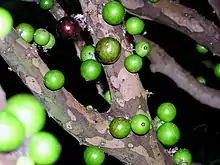Plinia peruviana
Plinia peruviana, commonly known as jabuticaba cabinho (small stemmed jabuticaba) in Brazil, is a species of plant in the family Myrtaceae. It is endemic to central, South America.
| Plinia peruviana | |
|---|---|
 | |
| Scientific classification | |
| Kingdom: | Plantae |
| Clade: | Tracheophytes |
| Clade: | Angiosperms |
| Clade: | Eudicots |
| Clade: | Rosids |
| Order: | Myrtales |
| Family: | Myrtaceae |
| Genus: | Plinia |
| Species: | P. peruviana |
| Binomial name | |
| Plinia peruviana (Poir.) Govaerts | |
| Synonyms[1] | |
| |
Description
Plinia peruviana is a tree that grows to between 4 and 14 metres tall, and is usually found in mixed araucaria forests, on alluvial plains and in open forest.[2] It produces edible fruit, between 18 and 25 mm in diameter, which is dark-purple in colour.[3] Unlike other Jabuticabas the fruits of Plinia peruviana are connected to the tree by long stems, resembling cherries.[4]
Uses
Fruits can be eaten fresh or made into jelly, juice, wine or liqueur.[5] Research has shown that the fruit has potential uses as a dye, flavouring or antioxidant.[6]
Extract from the fruit peel has been shown to be antifungal[7] and protect against copper toxicity.[8]
References
- "Plinia peruviana (Poir.) Govaerts". The Plant List. Retrieved 21 December 2020.
- "Plinia peruviana". Useful Tropical Plants. Retrieved 21 December 2020.
- Wua, Shi-Biao; Longa, Chunlin; Kennelly, Edward (2013). "Phytochemistry and health benefits of jaboticaba, an emerging fruitcrop from Brazil" (PDF). Food Research International. 54: 148–159. doi:10.1016/j.foodres.2013.06.021.
- "Jabuticaba para todos os gostos" (in Portuguese). Revista Natureza. June 13, 2018. Retrieved January 27, 2021.
- Susy Silveira, Sheila; Francisco Sant’Anna-Santos, Bruno; Degenhardt-Goldbach, Juliana; Quoirin, Marguerite (2020). "Somatic embryogenesis from mature split seeds of jaboticaba (Plinia peruviana (Poir) Govaerts)". Acta Scientiarum. Agronomy. 42.
- Wiszovaty, Lourdes; Caballero, Silvia; Oviedo, Cristian; Ozuna, Fernanda; Mereles, Laura (August 6, 2020). Plinia peruviana "Yvapurũ" Fruits and Marmalade from Paraguay: Autochthon Products with Antioxidant Potential. 2nd International Conference of Ia ValSe-Food Network. Lisbon, Portugal. doi:10.3390/proceedings2020053009. Retrieved February 4, 2021.
- Waller, Stefanie; Peter, Cristina; Hoffmann, Jéssica; Cleff, Marlete; de Faria, Renata; Zani, João (2020). "Jabuticaba [Plinia peruviana (Poir.) Govaerts]: a Brazilian fruit with a promising application against itraconazole-susceptible and -resistant Sporothrix brasiliensis". Natural Product Research. 35 (24): 5988–5992. doi:10.1080/14786419.2020.1810034. PMID 32840143. S2CID 221309051. Retrieved December 21, 2020.
- Franscescon, F.; Mazon, S.C.; Bertoncello, K.T. (2018). "Protective role of jaboticaba Plinia peruviana peel extract in copper-induced cytotoxicity in Allium cepa". Environmental Science and Pollution Research. 25 (35): 35322–35329. doi:10.1007/s11356-018-3420-1. PMID 30341761. S2CID 53009912. Retrieved December 21, 2020.